Tom's Hardware Verdict
The MSI Godlike performs above average in our testing and easily handled overclocking the Ryzen 9 5950X. With five M.2 sockets, two premium audio codecs, a watercooling ecosystem and an extreme overclocking capable power delivery, there is no doubt the features (and $699 price) are flagship class.
Pros
- +
19-Phase 70A Power Delivery
- +
Killer Network-based Wi-Fi and 2.5 GbE
- +
10 GbE AIC included
- +
Premium audio w/6.3mm jack
- +
Five M.2 slots
Cons
- -
No video outputs
- -
Only six rear USB ports
- -
Expensive
Why you can trust Tom's Hardware
The MSI X570 Godlike motherboard isn’t new -- in fact, we’ve used it as our test platform in some AMD CPU reviews. But we’ve never had the chance to review it, and given that the Ryzen 9 5950X is our new test CPU, we’ve decided to put this flagship board through its paces with AMD’s latest flagship silicon.
The bold Godlike name infers this is one of the best out there, and to be frank it isn’t very far off, if price isn’t much of an issue. The $699.99 Godlike includes robust power delivery, a premium audio solution, five M.2 sockets and a cool-looking monochrome OLED screen, all of which are fitting for a flagship-class part.
At the time of publishing, MSI’s X570 lineup consists of nine boards, starting with the X570-A Pro ($159.99) and including multiple parts from the MAG line (Tomahawk WiFi), the MPG line (Gaming Plus, Gaming Edge WiFi, and Gaming Pro Carbon WiFi), and the premium MEG lineup (Unify, Ace, and Godlike). From E-ATX flagships like the Godlike to entry-level boards, there is something for everyone in MSI’s X570 range.
Focusing on performance, the Godlike did well in our benchmarking suite, running most tests on the faster side of average. Even in the PCMark 10 MS Office/Application testing, where we often see anomalies, we saw consistent results across the full gamut of testing. The board allowed the 5950X to reach its full 5 GHz boost, so we’re getting all we paid for at default settings. As expected, overclocking on this motherboard went without a hiccup, easily handling our 16-core/32-thread CPU. VRM temperatures at load were some of the lowest we’ve seen as well.
Performance isn’t everything, however. The features list is long and the Godlike includes a 10 GbE add-in-card (AIC) in addition to the existing 1 and 2.5 GbE ports, dual Realtek ALC1220 codecs and two additional PCIe 4.0 x4 M.2 sockets via add-in-card. Features and specifications aren’t everything either, though. The appearance of the X570 Godlike is also solid. The Infinity RGB display around the VRMs, coupled with the customizable OLED screen and the overall clean look set this board apart from other less expensive models. Read on for additional details about the X570 Godlike, because there’s a lot here to cover.
Specifications - MSI X570 Godlike
| Socket | AM4 |
| Chipset | X570 |
| Form Factor | E-ATX |
| Voltage Regulator | 19 Phase (14+4+1, 70A MOSFETs) |
| Video Ports | ✗ |
| USB Ports | (2) USB 3.2 Gen 2, Type-A and Type-C (10 Gbps) |
| (2) USB 3.2 Gen 2, Type-A (10 Gbps) | |
| (2) USB 3.2 Gen 1, Type-A (5 Gbps) | |
| Network Jacks | (1) 2.5 GbE |
| (1) 1 GbE | |
| (1) 10 GbE (via Add-in-card) | |
| Audio Jacks | (5) Analog + SPDIF + 6.3mm outputs |
| Legacy Ports/Jacks | ✗ |
| Other Ports/Jack | ✗ |
| PCIe x16 | (3) v4.0 (x16), (x16/x0/x0 or x8/x0/x8, or x8/x4/x4) |
| (1) v4.0 (x4) | |
| PCIe x8 | ✗ |
| PCIe x4 | ✗ |
| PCIe x1 | ✗ |
| CrossFire/SLI | AMD Quad CrossfireX and CrossFireX (2/3-Way), 2-Way Nvidia SLI |
| DIMM slots | (4) DDR4 5000+(OC), 128GB Capacity |
| M.2 slots | (1) PCIe 4.0 x4 / PCIe + SATA (up to 110mm) |
| (1) PCIe 4.0 x4 / PCIe + SATA (up to 80mm) | |
| (1) PCIe 4.0 x4 / PCIe only (up to 110mm) | |
| (2) PCIe 4.0 x4 / PCIe only (up to 110mm, via Add-in-card) | |
| U.2 Ports | ✗ |
| SATA Ports | (6) SATA3 6 Gbps (RAID 0, 1 and 10) |
| USB Headers | (1) USB v3.2 Gen 2 (Type-C) |
| (2) USB v3.2 Gen 1 | |
| (2) USB v2.0 | |
| Fan/Pump Headers | (9) 4-Pin |
| RGB Headers | (2) aRGB (3-pin) |
| (1) RGB (4-pin) | |
| (1) Corsair LED (3-pin) | |
| Legacy Interfaces | ✗ |
| Other Interfaces | FP-Audio, TPM |
| Diagnostics Panel | Yes (2 character LED), Dynamic Dashboard |
| Internal Button/Switch | Power and Reset, OC Knob, BCLK+/- |
| SATA Controllers | ASMedia ASM1061 |
| Ethernet Controller(s) | (1) Killer E3000 (2.5 GbE) |
| (1) Killer E2600 (GbE) | |
| Wi-Fi / Bluetooth | Killer AX1650x (802.11ax, 2x2, MU-MIMO, BT 5.1) |
| USB Controllers | ASMedia ASM1042 |
| HD Audio Codec | (2) Realtek ALC1220 |
| DDL/DTS Connect | ✗ / ✗ |
| Warranty | 3 Years |
Inside the box along with the motherboard is a whole lot of accessories. Outside of the usual selection of SATA cables, driver disks, and guides, the Godlike includes multiple add-in-cards (10 GbE, M.2 Expander), thermistors, and more. This accessory stack is the biggest we’ve seen in a while. Below is a complete list of the included extras.
- (6) SATA cables
- 1 to 2 RGB LED extension Y cable (80cm)
- Corsair RGB LED extension cable (50cm)
- Rainbow RGB LED extension cable (10cm)
- (2) Thermistor cables
- Wi-Fi Antenna
- M.2 Expander-Z Gen4 AIC
- 10G Super LAN AIC
- 6.3mm audio adapter
- Case badge
- SATA Cable labels
- Driver DVD
- Manual, Quick Guide, Quick Installation Guide
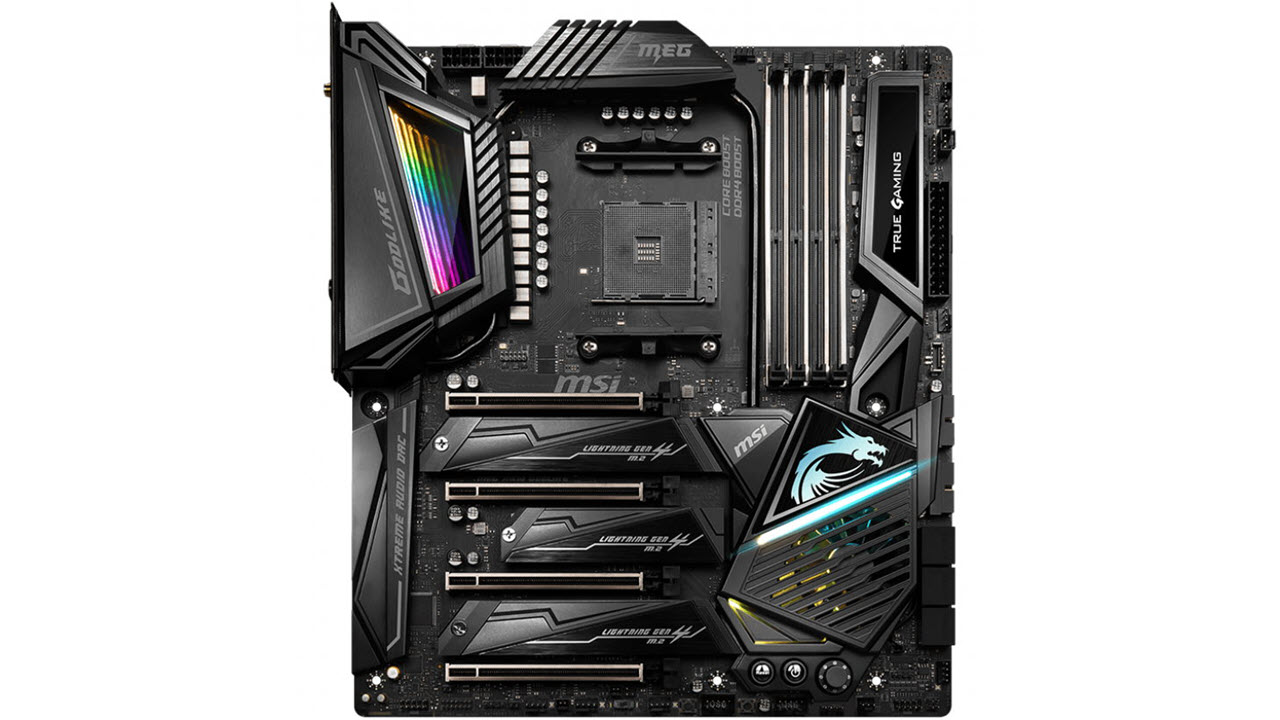
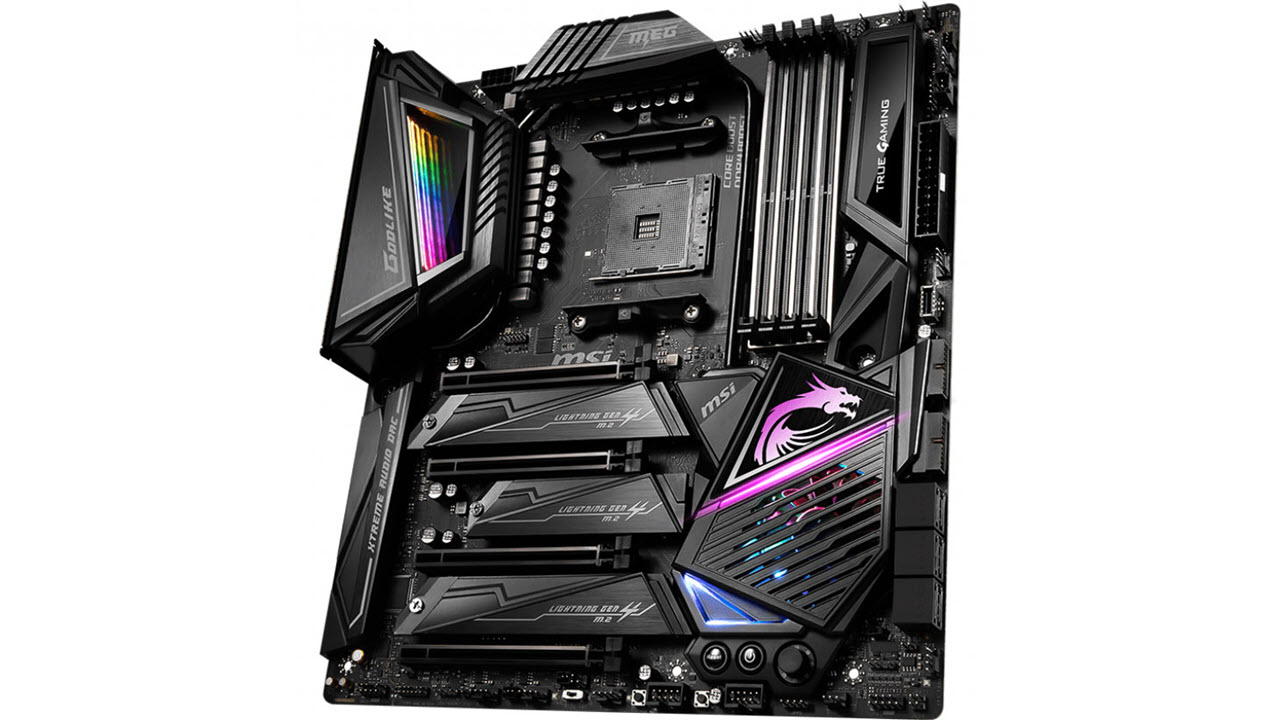
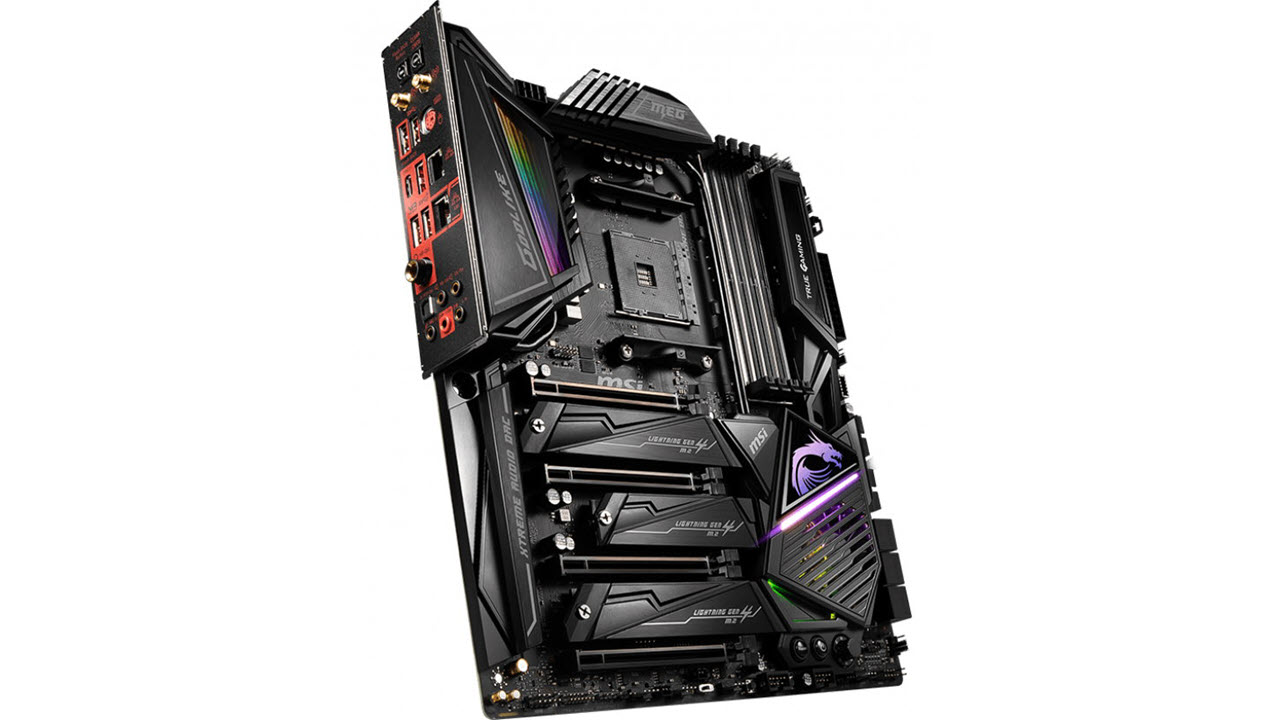
When you first take the Godlike out of the box, you’re greeted by an attractive board that will fit in with most build themes. The PCB is matte-black, as are all heatsinks and shrouds. The large brushed-aluminum finish VRM heatsinks connect via heatpipe to each other and the chipset heatsink, sharing the thermal load between them. The DRAM and PCIe slots are all reinforced using MSI’s PCIe Steel Armor, protecting against bending/shearing and EMI.
On the RGB front, the Mystic Light Infinity II feature above the VRM area steals the show. Through the magic of light and mirrors, the RGB lighting looks like it goes down to infinity, offering a truly unique look. The chipset heatsink also sports RGB lighting, with the familiar MSI Dragon illuminated just above the chipset fan. Additionally, the customizable OLED panel located to the DRAM slots’ right brings another unique aesthetic to a motherboard. MSI’s Mystic Light software controls all of the LEDs and the OLED screen. In short, the X570 Godlike looks the part of a high-end motherboard and includes some cool features to set it apart from other high-end alternatives.
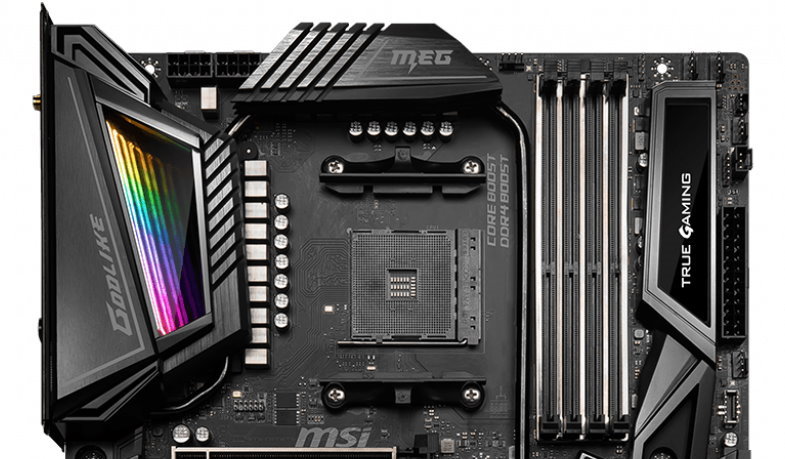
Starting with the board’s top half, we get a closer look at the Infinity RGB display above the heatsink on the left-hand side. The mirror reflection system does a great job of showing off the RGBs differently from most motherboards. Above this and the large VRM heatsink are two 8-pin EPS connectors (one required) that send power to the CPU. The socket area is clear of most hazards and begs to have a pot on top for some sub-ambient fun.
To the right of the socket are four reinforced DRAM slots. Capacity is listed up to 128GB, while the supported speeds are close to the fastest we’ve seen listed, at DDR4 5000+(OC). As always, your mileage may vary on reaching sky-high speeds such as that. AMD’s sweet spot, even with the 5000 series processors, still sits at DDR4 3600/3733 with the Infinity Fabric tied to it (1:1). Reserved for benchmarking, these speeds benefit those shooting for world records more than it does for real-world performance gains.
Above the DRAM slots are the first three (of nine) 4-pin fan headers. Each fan header supports both PWM and DC controlled devices. The board will automatically detect what is connected and adjust the mode accordingly. MSI doesn’t list how much power these will output in the manual, but we reached out to the company and have answers. All 4-pin headers are 1A/12W, except for the pump header at 3A/36W. If only by the sheer count of fan headers, there should be plenty of power available to connect your pump and fans to the motherboard. Each header even has a LED next to it that tells you what mode the board is using. You’ll see red for PWM fans and white in DC mode. I don’t recall seeing this before, but this nifty little add-on can be helpful for troubleshooting and gives users information on how the fans connect at a glance, without going into the BIOS.
To the right of the socket is MSI’s OLED-based Dynamic Dashboard. Used for a slew of things, the Dynamic Dashboard displays CPU temperature/speed, BIOS flash status and error messages. The monochrome dashboard is customizable, even allowing you to upload a .GIF animation file to display. If there is an error during POST, the dashboard displays the part causing the issue listing the location and error on the screen. Couple that with the two-character debug LED and the four ‘dummy’ LEDs onboard and you should know what’s going on with this motherboard at all times. While it’s arguably overkill for the average user, for those benchmarking and pushing overclocking limits, this can be very helpful to troubleshoot issues efficiently.
In between these headers on the top of the board is the first (of four + Corsair RGB) RGB headers. In this case, it’s a 4-pin RGB. You’ll find the other three headers on the bottom edge of the board. The Mystic Light RGB application controls the RGB lighting. We’ve had no issues with this software providing proper control in our testing.
To the right of the DRAM slots and Dynamic Dashboard are a few more headers and connectors. From the top-down is the first of two temperature sensors, SYS_FAN2 header, the Corsair header, 24-pin ATX power connector, SYS_FAN3 header and a USB 3.2 Gen2 Type-C front panel connector.
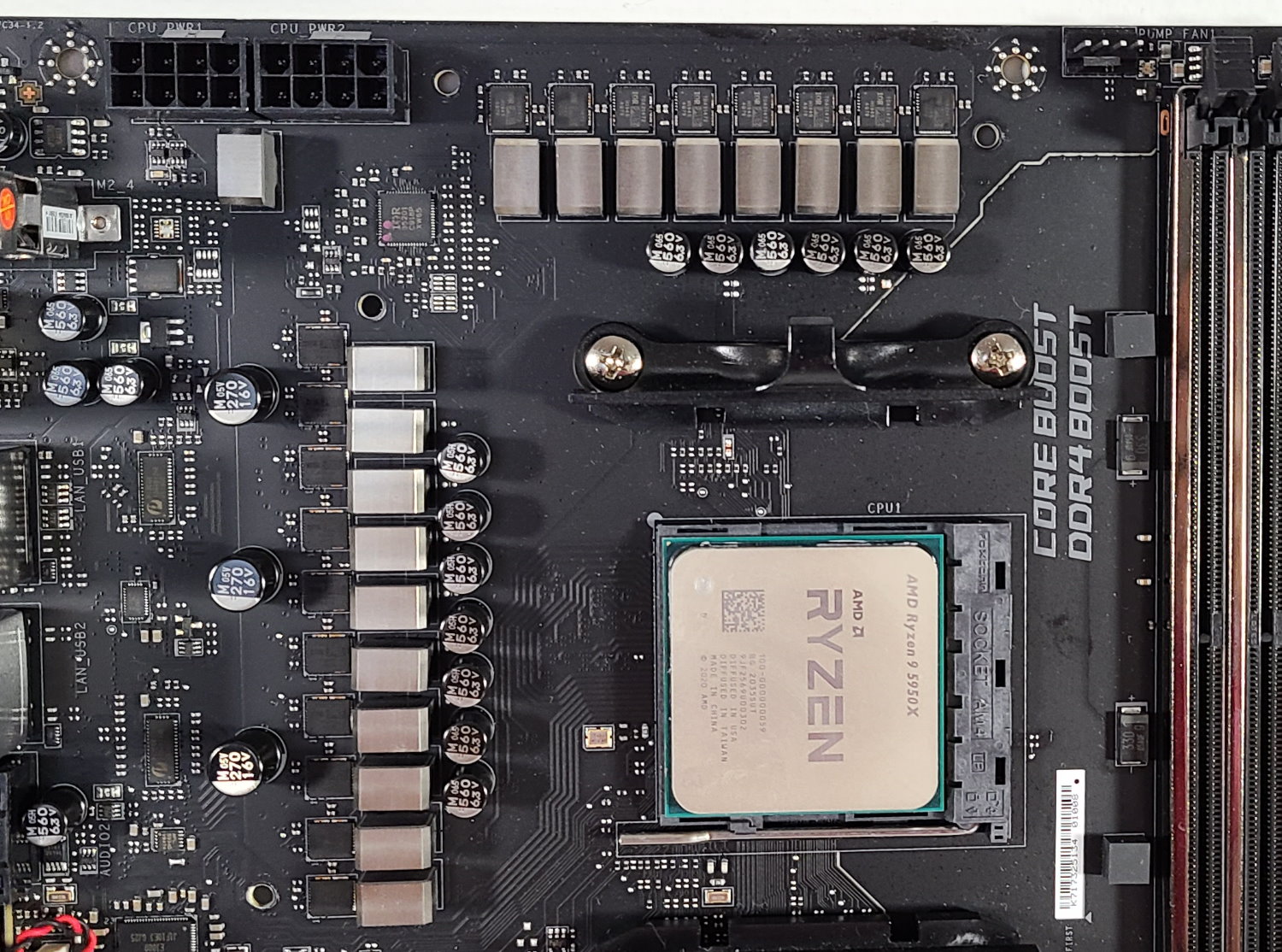
The MSI X570 Godlike runs a total of 14 phases for Vcore and a 4-phase configuration on the SoC. Managing power is a premium International Rectifier IR35201 (x+y=8) buck controller that sends power to seven IR3599 doublers, then on to 14 70A Infineon TDA21472 MOSFETs. The 980A available for the CPU/Vcore only is one of the highest we’ve come across so far. We had no issues whatsoever overclocking our flagship Ryzen 9 5950X CPU. The VRMs remained cool throughout all of our testing. If sub-ambient cooling and benchmarking are your thing, the VRMs will serve you well. Of course, ambient overclocking won’t be an issue either.
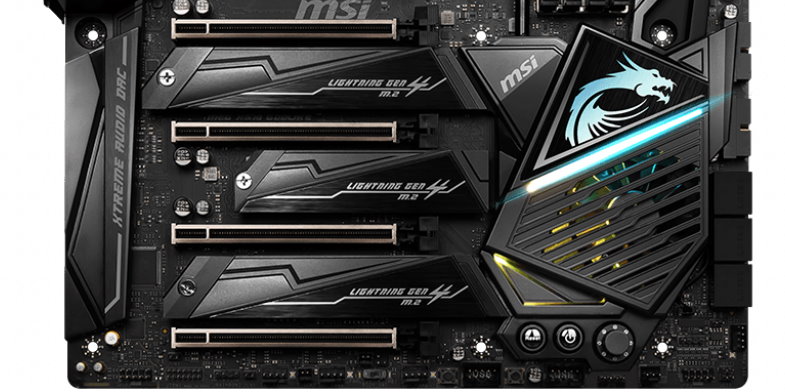
Moving to the bottom half of the board, we’ll start on the left side with the audio section. Hidden underneath the shroud are two (yes, two) Realtek ALC1220 codecs. The first is for the rear panel audio connectors, with the second dedicated for front-panel audio. An ESS E9018 Sabre DAC drives the 6.3mm stereo headphone output on the back panel. If you don’t have a 6.3mm headset, a 3.5mm-to-6.3 adapter is included if you’d like to use this port. Rounding out the audio section are 12 yellow Nippon audio caps and four WIMA audio caps (red). Overall, the audio solution is well above average, using premium codecs and a quality integrated DAC. The 6.3mm jack on the back is truly something unique on a motherboard.
In the middle of the board are four reinforced PCIe slots. Intended for GPUs, the top three slots support PCIe 4.0 x16 and break down to x16/x0/x0 or x8/x0/x8, or x8/x4/x4 when all three slots are populated. The fourth/bottom slot is sourced from the chipset and provides PCIe 4.0 x4 lanes. If you plan on using the M.2 Xpander and 10 GbE AICs, that leaves you with two full-size PCIe slots for video cards.
Between the PCIe slots are three M.2 sockets, each with their own heatsinks. The top two (M2_1 and M2_2) support both PCIe 4.0 x4 and SATA-based modules. M2_1 supports up to 110mm modules while M2_2 supports up to 80mm devices. The bottom slot, M2_3, supports PCIe only and drives up to 110mm long. If these three aren't enough, the M.2 expander card adds two more M.2 sockets. To get the full bandwidth from the AIC, install it in a slot that offers PCIe 4.0 x8 bandwidth (third slot down with nothing installed in the second slot). If you need a whole lot of wicked fast NVMe based storage, this motherboard supports it!
To the right of the M.2 and PCIe area are the chipset heatsink and fan. The large fan was inaudible during our testing, though we weren’t using any chipset-connected PCIe 4.0 devices so the stress level is lower. On the right edge are two USB 3.2 Gen 1 front-panel ports along with six SATA ports. SATA ports 1-4 are fed from the chipset, while ports 5/6 source their lanes from the ASMedia ASM1061 chip. The AMD chipset connected ports support RAID0, 1 and 10 modes, which is typical.
Across the bottom are several buttons and headers ranging from front panel audio to power and reset buttons. A lot is going on down there, especially for hardcore overclockers, where you’ll find BCLK buttons and other extreme overclocking functions. Also worth noting in this section are the temperature sensors and water flow headers. With these on board, you’re able to monitor and then control attached devices through the MSI software and the BIOS. Here’s the full list, from left to right:
- Front panel audio
- TPM header
- 3-pin RGB header
- LN2 mode header
- Fan header
- Temperature sensor header
- Fan header
- BIOS switch
- Fan header
- BCLK “-” button
- USB 2.0 header
- BCLK “+” button
- Reset and Power buttons
- OC knob
- USB 2.0 header
- Front panel header
- Water flow header
- Clear CMOS header
- Slow mode jumper
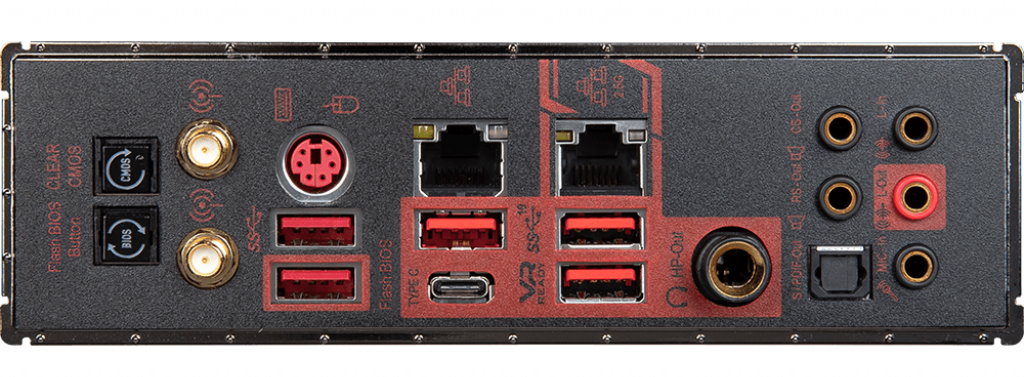
MSI’s rear IO includes an integrated plate with a black and red theme. On the left are two buttons, one that clears the CMOS and the other used for the board’s BIOS flashback capabilities. Moving right, we spy the two WiFi antenna mounts, two USB 3.1 Gen 1 ports and above that, a legacy PS/2 mouse/keyboard port. Next are the two Killer-based Ethernet ports that reside above the four USB 3.2 Gen 2 ports (one Type-C). To the right of that is one of the most unique features on this motherboard, a 6.3mm audio jack that uses the integrated DAC. Finally, the rest of the audio stack consists of a 5-plug analog and SPDIF stack.
MORE: Best Motherboards
MORE: How To Choose A Motherboard
MORE: All Motherboard Content

Joe Shields is a Freelance writer for Tom’s Hardware US. He reviews motherboards.
-
steedamike Reply
gg83 - I'd probably not use the built-in dac/amp on the motherboard. From what little I just read about a few minutes ago, there may be some electromagnetic interference and/or crosstalk within a CPU case, especially under load. Also, according to this article, the power output from motherboards is less than 10 mw, which is low. As far as needing high-end, well, high-end is relative. I'd bet 99% of listeners would be totally happy with a $200 Schiit stack dac/amp combo (modi + magni). The Magni generates 2,400 mw at 32 ohms, quite a bit more than 10. This should power 99.9% of headphones to far beyond healthy db levels (some planar magnetic cans can suck up a lot of juice, though). As for DAC sound quality, I really can't speak on that because I don't have a golden ear that can tell much difference during critical listening.gg83 said:Would you need a high-end DAC to use a solid audiophile headphones? -
Jac1023 Reply
This would probably drive most headphones. Dynamics better than planars most likely. But a seperate dac and amp will almost always be an upgrade, particularly if you are using playback or streaming software that supports exclusive mode, ie cutting the windows sound mixer "middle man" out of the equation.gg83 said:Would you need a high-end DAC to use a solid audiophile headphones?
Not to knock anyones setup, but if someones just using spotify or youtube music, dont bother with an outboard DAC, put an extra couple hundred in your headphone budget and have fun, don't go down the rabbit hole lol -
Jac1023 I cant really use all the M.2 at full capacity right? Some would have to be at sata level becuase of pcie lanes?Reply -
edwjohn3 Reply
Right?? I feel like anyone seriously considering this board should just spring for Threadripper.Jac1023 said:I cant really use all the M.2 at full capacity right? Some would have to be at sata level becuase of pcie lanes? -
CthulhusBff Reply
The 5950x has 40 PCI lanes. If you bought this board. Why wouldn't you get the 5950x?Jac1023 said:I cant really use all the M.2 at full capacity right? Some would have to be at sata level becuase of pcie lanes? -
Makaveli ReplyAlvar Miles Udell said:Remember when $200 bought you a -really- good AMD motherboard...
I paid $280 CAD for my board and I like it. I would never spend $400-$500 on a board so I wouldn't have looked this board anyways.
CthulhusBff said:The 5950x has 40 PCI lanes. If you bought this board. Why wouldn't you get the 5950x?
You need to look at the distribution of those lanes and how the M2's will access them and that will explain what they are referring too. -
mrv_co What is the use case for 'Video output' for a board in this class? The lack of video output shows up as a 'con', but it is not mentioned at all during the write-up.Reply -
ashburner I have this board and I like it a lot. Running it with a 5950X on auto overclock and it peaks just over 5Ghz. Silent and sitting at 51C.Reply